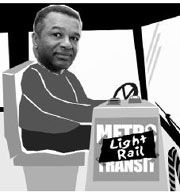ARE KING COUNTY voters willing to bail out light rail while they’re saving Metro? Ron Sims and the local business lobby appear to hope so.
The King County executive is attempting to put a sales tax hike on the ballot this November to help support Metro bus service, which faces a massive funding cut-off next year because of Initiative 695. But Sims also wants to take a significant amount of the money raised, $440 million, and give it to Sound Transit for light rail.
Sims is justifying his proposal with a poll—paid for, as it happens, by Puget Sound business interests and disseminated by corporate public affairs operators Gogerty Stark Marriott. This poll’s data supposedly show King County voters will not support a modest tax hike that staves off cuts to Metro. Voters will only support a bigger tax increase, with additional transit projects, including light rail.
“We were really surprised at that,” Sims said recently, speaking on KUOW, “because we realized the voters were taking an expansive view of what the county should do.”
But are the voters speaking or being led by the nose?
LIGHT RAIL IS presenting quite a pickle to Sims and other political leaders, as well as the downtown business community, many of whom supported the original Sound Transit plan. The project is already in deep financial straits, even before a single tunnel has been dug. What’s more, under the current plan the rail line will end at the University District. This fact, combined with the requirement that Metro buses get out of the downtown bus tunnel and onto downtown streets, has many experts predicting that the system will make local traffic congestion worse, not better.
The only hope for mitigating these effects is to somehow get the trains up to Northgate.
And here, perhaps, is where the poll comes in. David Schaefer of Gogerty Stark will not say who specifically put up the funds to take the poll, though he says it was large, well-known corporate interests “concerned about transportation and congestion.”
As always with polls, you phrase the question the right way, you get the answer you want. The full text of the poll has not been released, so we don’t know everything that people on the telephone were asked or told. But Schaefer did agree to share two of the questions. In the first, voters were asked their view of a rather conservatively worded tax proposal: $80 million annually that would “allow the county to make up for some of the budget cuts as a result of I-695, preserving the current level of bus service in the county.” This one passed by one percentage point.
The second, more enticing, plan “would raise $120 million annually to improve bus service and invest in 25-year bonds to pay for extending light rail to Northgate, adding a stop at Southcenter, synchronizing traffic lights, adding new park and ride lots, and improving HOV lane and transit access on Interstate 90.” That one passed by 20 percentage points. (In truth, the $120 million plan won’t even be sufficient to get light rail to Northgate and Southcenter, but no matter.)
When asked about the wording, Schaefer says, “It’s possible you could word it differently and get a different result. But that’s not what we’re about here. Clearly the second of the two offers more. But it also costs more.”
Sims, explaining on the radio why he favors the bigger sales tax increase, remarked: “You don’t want to start a campaign where the difference is 1 percent. The only thing that moved people was the light rail features, the traffic light synchronization. And the people who [changed their vote] were the people in suburban areas. And that was really important for us because that’s where this is going to be decided.”
YET IT’S HARD to imagine that bringing light rail to Northgate is a big vote-getter out in Issaquah. And indeed the non-Seattle members of the King County Council have been largely opposed to the Sims plan. The council will bring it up for consideration on September 11.
King County Council member Maggie Fimia, a bus commuter herself from Shoreline, has been gathering support for an alternative Metro-only plan. “I can defend Metro,” says Fimia. “But I don’t want to have to defend these other projects. Too many people who know about [the light rail plan] say it’s going to be a disaster.”
The ultimate key to the poll puzzle, and to the Sims proposal, may be the need to have business on board in order to fund the protransit ballot, whatever form it takes. Schaefer notes that, since public money can’t be used for this sort of effort, “what they usually do for a nonpartisan proposition or initiative campaign is go to corporate givers and ask them for money to support the measure. Some of the people who likely would be asked are the people who paid to have this poll done.” While saying that he could not speak for his clients’ specific interests here, Schaefer speculated, “Maybe they’d want to know if this is something they should get behind?”








